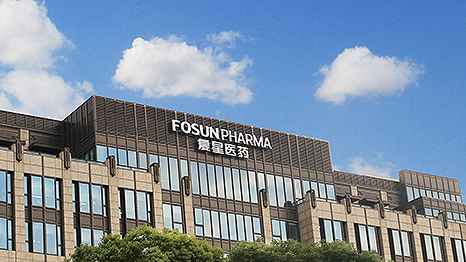Nature Dialogue with Dr. Aimin Hui: How to Lead R&D of Innovator Drugs?
Chinese pharmaceutical companies are turning their attention to innovation, shifting rapidly from mastery of follow-on drugs to researching first-in-class and best-in-class drugs. Aiming to be a healthcare group with a global presence, Fosun Pharma, established in Shanghai in 1994, has built its core business around innovative drug R&D and manufacturing.
Fosun Pharma’s executive president, president of global R&D, and chief medical officer, Aimin Hui, says the company’s R&D aims to leapfrog the latest international cutting-edge technology in the field.
Teaming with the most innovative players
Initially a generic drugs manufacturer, Fosun Pharma switched to pursuing innovative drugs about a decade ago. “Our independent in-house R&D began in 2009 and since then we have established our small molecule drug platform and biopharmaceutical platform,” Hui says. “Over the last four years, in particular, we have been tracking world-class technologies.”
Through its partnership in 2017 with California-based Kite Pharma, Fosun Pharma has been co-developing the CAR-T therapy in China. Its biopharmaceutical platform, Henlius is developing biosimilars and innovative biologic medicines for oncology, autoimmune diseases, and ophthalmic diseases.
In June 2021, Fosun Kite’s autologous CD19-directed CAR-T cell therapy Axicabtagene Ciloleucel, was the first CAR-T therapy approved by China’s National Medical Products Administration for the treatment of adult patients with relapsed or refractory large B-cell lymphoma, opening a new era of cell therapy in China.
One exciting R&D activity for Fosun Pharma, Hui says, is the collaboration with Germany-based mRNA developer, BioNTech, that launched the COVID-19 vaccine, more recently known as COMIRNATY, to the Greater China market.
“We’ve followed the development of mRNA technologies for a long time,” Hui says, “The COVID-19 outbreak triggered the explosion of mRNA technologies that are now critical in containing the global pandemic.”
The Fosun Pharma and BioNTech partnership delivered the mRNA-based COVID-19 vaccine that is now included in vaccination programmes in Hong Kong SAR and Macau SAR. Fosun Pharma also provided 15 million doses of this vaccine to Taiwan for use in local vaccination by the disease control authority.
“Vaccine is the ultimate weapon,” Hui says. “The objective of Fosun Pharma is very clear: to bring effective and safe vaccines to China, especially vaccines via different technical routes.”
Fosun describes it approach to R&D as patient-centered and clinically driven, while also seeking technological innovation.Credit: Fosun Pharma
R&D to commercialization, an integrated system
After years working in R&D for international pharmaceutical companies, Hui joined Fosun Pharma in late 2017, attracted by its inspiring development strategies. Hui explains that Fosun Pharma is an integrated healthcare service, by offering diagnosis, medical devices, and healthcare services, in addition to pharmaceutical R&D, manufacturing, distribution and retail. Distribution and retail are key elements for accessing the Chinese pharmaceutical market.
Fosun Pharma has formed a strategic alliance with Sinopharm Holdings, one of the largest drug suppliers in China, and in June 30, 2021 held almost 25% equity in the company. In addition, Fosun Pharma also controls several medical service institutions—a total of 4,732 public beds—on the China Mainland.
“We are a leader in the Greater China region in terms of clinical R&D capability, registration capability and commercialization capability.” Hui says, “Our strength comes from a well-integrated ecosystem.”
Future areas of focus
Hui was also drawn to Fosun Pharma for its approach to R&D that is patient-centered and clinically driven, while also seeking technological innovation.
“We seek innovation with a Chinese focus,” Hui explains. When developing oncology drugs, for instance, Fosun Pharma focuses on liver, gastric, oesophageal and other cancers: these are prevalent in China but lack effective drugs. “We can provide better benefits to our patients and are more likely to succeed in drug development, given a lack of effective treatments and more patient resources for clinical studies,” Hui adds.
In addition to oncology, focus areas in Fosun Pharma’s R&D include immunology, neurology, metabolic diseases, and infectious diseases. Another speciality, Hui explains is “PCG or protein therapy, cells therapy and gene therapy, which is the most cutting-edge technological concept and the one that will help us to leap forward.”
Internationalization is the only way
If Chinese pharmaceutical companies really want to expand globally, they must internationalize, Hui argues, “and you certainly can’t do that just by having people in China. “
To attract foreign talent, in 2020 Fosun Pharma established a global R&D center and an R&D platform in the Bay Area, California, New Jersey and Boston. The US-based and the China-based teams can work together seamlessly around the clock: as the sun sets on the team in the US, it rises for the team in China.
Such global teamwork has advantages, Hui says, citing Fosun Pharma and BioNTech’s initial proposal to develop the COVID-19 vaccine. Thanks to the nonstop global network it took only 48 hours to complete the plan for its development, and registration in China.
Hui says to internationalize R&D is the first step, but the ultimate goal to also internationalize commercialization. “International pharmaceutical companies sell their products in more than 100 countries. That’s why they are recognized names.” Hui says, “Doing international sales is as important as doing international R&D.”
But to obtain market approval from regulators in the US and EU, means expanding clinical trials beyond China. So Fosun Pharma has established teams for clinical research teams and regulatory affairs in the US and Europe.
“So far Chinese pharmaceutical companies still haven’t come up with first-in-class or best-in-class drugs.” Hui says, “Our dream is for that to change within five to ten years.”





